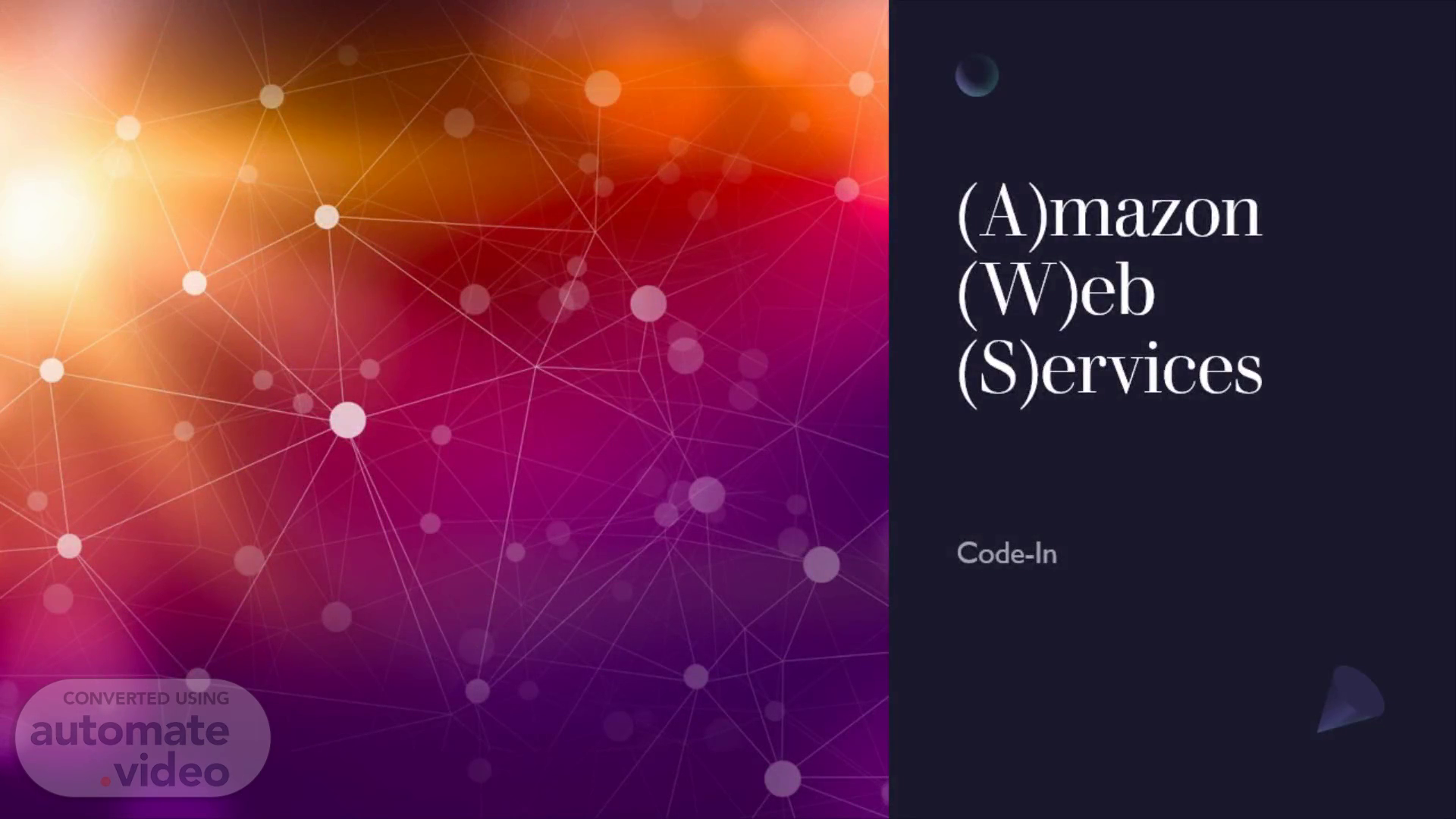
Page 1 (0s)
(A)mazon (W)eb (S)ervices. Data Points Digital background.
Page 2 (7s)
Agenda. What is Cloud Computing? Who is using Cloud Computing? Benefits of Cloud Computing Characteristics of Cloud Service Categories of Cloud Computing.
Page 3 (21s)
What is Cloud Computing?. 1/23/2022. AWS. 3. Cloud computing is the on-demand delivery of IT resources over the Internet with pay-as-you-go pricing. Instead of buying, owning, and maintaining physical data centers and servers, you can access technology services, such as Storage, Database, Networking, Developer tools, on an as-needed basis from a cloud provider like Amazon Web Services (AWS)..
Page 4 (42s)
1/23/2022. AWS. 4. Organizations of every type, size, and industry are using the cloud for a wide variety of use cases, such as data backup, disaster recovery, email, virtual desktops, software development and testing, big data analytics. For example, Healthcare companies are using the cloud to develop more personalized treatments for patients. Financial services companies are using the cloud to power real-time fraud detection and prevention. And video game makers are using the cloud to deliver online games to millions of players around the world..
Page 5 (1m 10s)
1/23/2022. AWS. 5. Agility Elasticity Cost Savings Deploy Globally in Minutes.
Page 6 (1m 20s)
1/23/2022. AWS. 6. The cloud gives you easy access to a broad range of technologies so that you can innovate faster and build nearly anything that you can imagine. You can quickly spin up resources as you need them–from infrastructure services, such as storage, and databases, to Internet of Things, machine learning, data lakes and analytics, and much more. You can deploy technology services in a matter of minutes and get from idea to implementation several orders of magnitude faster than before. This gives you the freedom to experiment, test new ideas to differentiate customer experiences, and transform your business..
Page 7 (1m 49s)
1/23/2022. AWS. 7. With cloud computing, you don’t have to over-provision resources up front to handle peak levels of business activity in the future. Instead, you provision the number of resources that you actually need. You can scale these resources up or down to instantly grow and shrink capacity as your business needs change..
Page 8 (2m 8s)
1/23/2022. AWS. 8. The cloud allows you to trade capital expenses (such as data centers and physical servers) for variable expenses, and only pay for IT as you consume it. Plus, the variable expenses are much lower than what you would pay to do it yourself because of the economies of scale..
Page 9 (2m 26s)
1/23/2022. AWS. 9. With the cloud, you can expand to new geographic regions and deploy globally in minutes. For example, AWS has infrastructure all over the world, so you can deploy your application in multiple physical locations with just a few clicks..
Page 10 (2m 43s)
1/23/2022. AWS. 10. National Institute of Standards and Technology (NIST) highlights various characteristics that are needed for a service to be regarded as “Cloud”. On-demand self-service - a cloud consumer can request a new virtual machine at any time and expects to have it working in a couple of minutes. The underlying hardware, however, might take 90 days to get delivered to the provider Broad network access - means resources hosted in a private cloud network (operated within a company's firewall) that are available for access from a wide range of devices such as tablets, PCs, Macs and smartphones Resource Pooling - In a multitenant environment, a single instance of an IT resource, such as a cloud storage device, serves multiple consumers. Rapid Elasticity - Since consumers can ask for and get resources at any time and in any quantity, the cloud must be able to scale up and down as load demands. Measured Service – Billing is metered and delivered as a utility service..
Page 11 (3m 23s)
1/23/2022. AWS. 11. The main types of cloud computing include Software as a service (SaaS) Platform as a service (PaaS) Infrastructure as a service (IaaS) Function as a service ( FaaS ).
Page 12 (3m 36s)
1/23/2022. AWS. 12. SaaS means instead of installing software on your computer, you access the platform online. Examples: There are loads: Google G-Suite, Dropbox, Cisco Webex , Concur, Microsoft O365, Genesys , PayPal SaaS models are preferred by small and medium-sized businesses that do not wish to invest heavily in IT maintenance..
Page 13 (3m 56s)
1/23/2022. AWS. 13. PaaS provides computing platforms such as operating systems, programming language execution environments, databases, and web servers. Examples: Salesforce, AWS Elastic Beanstalk, Heroku, Google App Engine (GAE), and OpenShift. PaaS is preferred by IT in hybrid cloud environments..
Page 14 (4m 13s)
1/23/2022. AWS. 14. IaaS provides infrastructure components such as servers, storage, networking, security, and moreover the cloud. Examples: Dropbox - a file storage and sharing system Microsoft Azure, AWS - which offers backup and disaster recovery services, hosting, and more It is especially effective for startups and organizations looking for agile scaling. It is also preferred by businesses that seek greater control over their resources..
Page 15 (4m 35s)
1/23/2022. AWS. 15. FaaS lets the developers write the codes and create several functions which when triggered can generate responses. These functions can be deployed in order to get responses. FaaS is very much closer to PaaS, but there’s a difference. In FaaS , you don’t need to deploy the whole application in the cloud. Instead, you can deploy a part of it. Examples: Amazon Lambda Google Cloud Functions Microsoft Azure Functions IBM Cloud Functions.
Page 16 (4m 59s)
The way to get started is to quit talking and begin doing..
Page 17 (5m 10s)
Thank You. Data Points Digital background. Data Points Digital background.